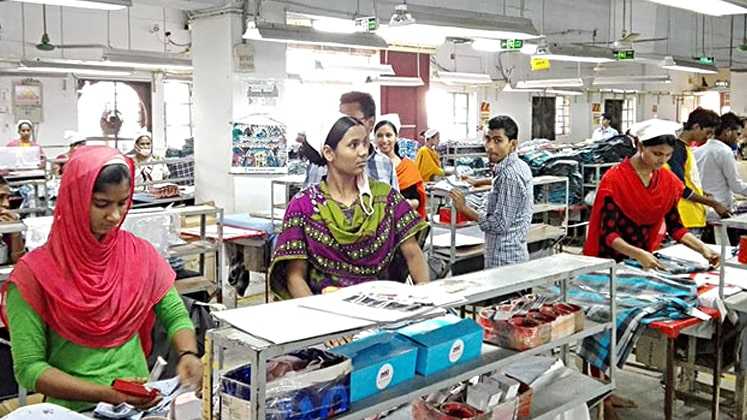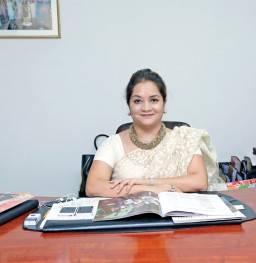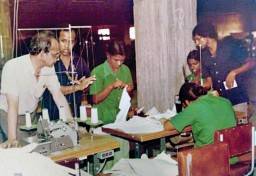
About 36 years ago, Md Noorul Quader, Abdul Majid Chowdhary and their team of 130 Bangladeshi operators and management trainees travelled to South Korea for six months of training in Daewoo’s state-of-the-art factories. Upon return, Noorul set up Desh Garments – Bangladesh’s first export-oriented garment manufacturing unit. Simultaneously, this expedition also catapulted the apparel manufacturing sector to the centre-stage of the Bangladeshi economy. The splendid story of the pioneer, who got it right the first time, does make one wonder about Desh Garment’s current whereabouts. Apparel Online traced the company and got to talk to Vidiya Amrit Khan, the vibrant, dynamic and young Director of Desh Garments and BGMEA and the daughter of Late Md Noorul Quader…

It was imminent for Desh Garments to go for liquidation or have a partner since the factory was based in Chittagong, while the Quader family was based in Dhaka, complicating the logistics and operations of the factory. But it was by chance or destiny that at the same time Vidiya had returned as a barrister, qualified from Inns of Court School of Law, London. She had her own premeditations over the future of Desh Garments and to carry forward her father’s lineage in exclusivity. Vidiya has been heading Desh Garments for six years now.
“I was much younger back then. Without realizing what I was getting into, I got into it,” she recalls. As the seemingly simple facade of the garment manufacturing industry unfolded, Vidiya became aware of the challenges that were to be overcome. Apart from the fact that Desh Garments had weathered multiple storms of banking, quota, political unrest, compliance and wage hikes, the company was yet to upgrade its infrastructure and management principles. “Considering all this, Desh Garments didn’t grow as it should have,” says Vidiya. Hence, Vidiya roped in a German consultant and a one-man legend as Vidiya calls him. Now Vidiya has the growth path charted out for Desh Garments. “It begins with minimizing the cost of what I am producing while maximizing my efficiencies. Following that it progresses to be more conscious of factory’s impact on environment and then perhaps I will go for value-added garments,” she explains.

Currently in the first phase, the first step for Vidiya was to set up an Industrial Engineering department and get rid of lethargic systems. “As opposed to the Production Manager, picking up a shirt and recommending a target empirically, our IE team establishes scientific targets,” Vidiya says. Naturally, since these targets are the basis of all estimations from manpower requirement to efficiency and productivity, a leaner factory has emerged. Subsequently, excessive manpower, generally helpers were eliminated and automats replaced old machines. Following this, the manpower requirement per line dropped by 30 per cent and the productivity and efficiency rose. During this period, the factory has expanded from 6 lines to 10 shirts lines. “I am very minimalistic. I don’t hold several production meetings either!” she tells on how she sustained the progress for this phase.
Vidiya has now set her eyes on ‘right first time’ quality principle. “Quality comes from the workers, it doesn’t come from the fact that an inspector has caught a defect 10 processes later and then sent it back for repair,” she explains. Vidiya believes that this mindset must be adopted by the middle management in the country now. “Our women have a natural flair for sewing. The focus should now shift from operators’ skill development to training the middle management as psychoanalysts besides having the right communication skills as they are the people who practically spend the entire day interacting with the operators,” Vidiya avers. According to Vidiya, it is crucial that the middle management is competent enough to troubleshoot and motivate an operator to work efficiently and make them realize that overtime is not how they will earn more money. “Our industry is 35 years old now. Our competencies should go beyond low price points and match China’s by now. That means shorter lead times, in-house fashion design teams and taking a deep plunge into high-fashion garments. Else we stand to lose our momentum to Cambodia, Vietnam, Indonesia, Myanmar and even Ethiopia because of its business, not philanthropy. Nobody will give me a relaxation if the power rates are high or if the Government is unstable,” elaborates Vidiya.
In Vidiya’s opinion, Government’s support in setting up supervisor training centres as CSR activities and a decentralized Dhaka, will give this process of change the much needed push. Meanwhile, Vidiya has combated these issues in her factory by maintaining a close relationship with her workforce. “As an owner, I communicate directly with my workers to keep them abreast of these principles and other developments and expansions. It is a constant struggle as there is a 26-27 per cent shortage of middle management in the country and the tendency to switch jobs for a few Takas is quite prevalent,” she admits.
Very sure that the industry is ready to jump start the second phase, Vidiya asserts the need of sustainability oriented manufacturing practices in the face of constantly rising gas and diesel prices. “Solar panels are bound to bring down the electricity cost for the factory and I would definitely like to install them in the near future,” she tells.
Nevertheless, Desh Garments is set for a two-fold increase in its capacities for the coming year. “I want the shirts that come out of my factory to be the best ones that come from Bangladesh,” affirms Vidiya. Simultaneously, the company will also be exploring the domestic market. “I would like to do it differently. What will be the difference? For now, I will keep mum over my plans for that,” she concludes.

Post a Comment